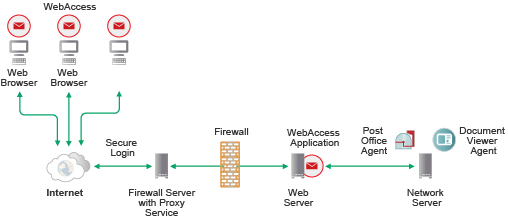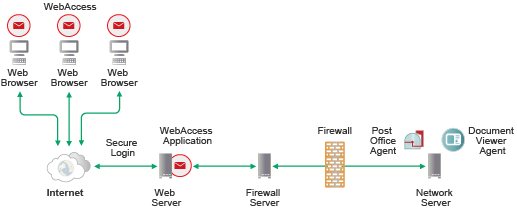17.1 GroupWise WebAccess Overview
IMPORTANT:GroupWise WebAccess is not supported in GroupWise 18.3 and later versions.
Functionality, components, and security requirements are explained in these sections.
17.1.1 GroupWise WebAccess Functionality
When used in a desktop web browser, GroupWise WebAccess provides much of the functionality available in the GroupWise client. On a tablet device, the most commonly used functionality is available. WebAccess functionality on mobile devices is limited compared to WebAccess in a desktop browser or on a tablet device.
See the following guides for WebAccess user functionality details:
After you set up GroupWise WebAccess, see What’s Next for additional information that you might want to be aware of as you configure, maintain, and expand GroupWise WebAccess.
17.1.2 GroupWise WebAccess Components
GroupWise WebAccess consists of four components: the browser-based WebAccess user interface (desktop computer, tablet device, or mobile device), the WebAccess Application, the Post Office Agent (POA), and the Document Viewer Agent (DVA).

-
WebAccess User Interface: The WebAccess user interface in web browsers gives users access to their GroupWise mailboxes anywhere an Internet connection is available.
-
WebAccess Application: The WebAccess Application, which resides on the web server, provides the GroupWise WebAccess user interface. As users perform actions in WebAccess, the WebAccess Application passes information between the web browser and the Post Office Agent.
-
Post Office Agent: The POA receives user requests from the WebAccess Application, accesses post offices and libraries to process the requests, and then passes information back to the WebAccess Application.
-
Document Viewer Agent: The DVA isolates the conversion process for attached document files. The DVA can simultaneously convert multiple document files into HTML format. If it encounters a problem converting a document file, the problem does not affect conversion of other document files, nor does it affect the functioning of the WebAccess Application. Therefore, GroupWise WebAccess users do not experience interruptions because of document files that fail to convert into HTML. Document files that fail in the conversion process simply cannot be viewed in WebAccess. The DVA is typically installed along with the POA.
17.1.3 WebAccess Security Requirements
The WebAccess Application can be configured to support the level of security you have established for your Internet/intranet communication.
If you are not concerned about security issues (for example, you only plan to use the WebAccess Application on a secured intranet), you can install the WebAccess Application to any web server that provides access for your users and meets the requirements listed in GroupWise WebAccess System Requirements.
If you plan to use the WebAccess Application to provide users with access to their mailboxes from anywhere on the Internet (rather than only within a secured intranet), and you already have a firewall in place to provide security, you have the following options for configuring the WebAccess Application:
-
Install the WebAccess Application inside your firewall and use a proxy service. See WebAccess with a Proxy Service. This is the recommended configuration.
-
Install the WebAccess Application on a web server outside your firewall, and install the POA and the DVA on a server inside your firewall. See WebAccess without a Proxy Service.
WebAccess with a Proxy Service
If your firewall includes a proxy service, you can install the WebAccess Application to a web server inside your firewall. The POA is located on a post office server, which is also inside the firewall.
In this configuration, only the firewall server with the proxy service is located outside the firewall, as shown in the following illustration.

WebAccess without a Proxy Service
If your firewall does not provide a proxy service, you need to install the WebAccess Application to a web server that is outside the firewall. The POA is located on a post office server, which is inside the firewall.
In this configuration, both the web server and the firewall server are located outside the firewall, as shown in the following illustration.

The firewall must allow inbound IP packets to be sent from the web server to the IP address and port of the POA (for example, 172.16.5.18:1677).
In addition, the firewall must allow outbound IP packets to be sent from the POA to the web server.